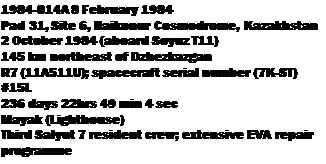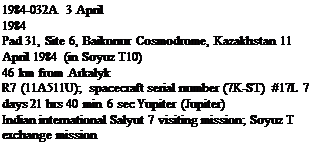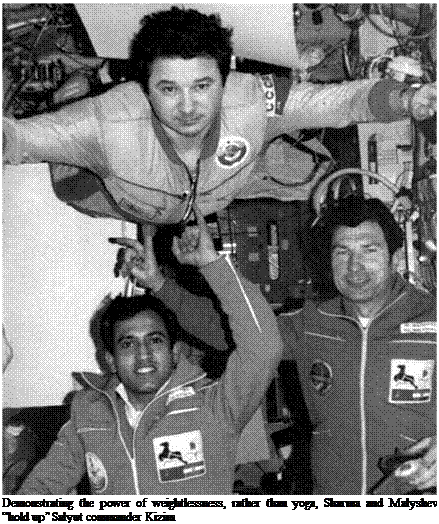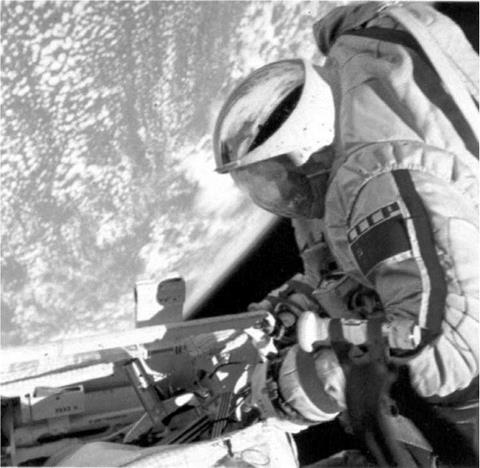STS 41-B
|
Int. Designation |
1984-011A |
|
Launched |
3 February 1984 |
|
Launch |
Site Pad 39A, Kennedy Space Center, Florida |
|
Landed |
11 February 1984 |
|
Landing Site |
Runway 15, Kennedy Space Center, Florida |
|
Launch Vehicle |
OV-099 Challenger/ET-10/SRB A57; A58/SSME #1 2109; #2 2015; #3 2012 |
|
Duration |
7 days 23 hrs 15 min 55 sec |
|
Callsign |
Challenger |
|
Objective |
Satellite deployment mission; first tests of Manned Manoeuvring Unit (MMU) |
Flight Crew
BRAND, Vance DeVoe, 52, civilian, commander, 3rd mission Previous missions: Apollo 18 ASTP (1975); STS-5 (1982) GIBSON, Robert Lee “Hoot”, 37, USN, pilot McNAIR, Ronald Erwin, 33, civilian, mission specialist 1 STEWART, Robert Lee, 41, US Army, mission specialist 2 McCANDLESS, Bruce II, 46, USN, mission specialist 3
Flight Log
The first flight of the manned manoeuvring unit apart, this mission offered one rather infamous distinction. Was it STS-10, STS-11 or STS 41-B? It was originally planned as STS-11 but when a military flight, STS-10, was delayed for what would turn out to be a year, STS-11 moved up one slot, becoming what would logically be called STS-10. Instead, it confusingly retained the STS-11 designation, and then NASA confused the numbering system even further by introducing an extraordinary system of nomenclature that would soon have most non-specialist space followers in a real pickle.
The “4” in STS 41-B represented the US fiscal year 1984. The “1” represented the Kennedy Space Center launch site (and a “2” would have referred to Vandenberg Air Force Base in California, where Shuttle missions were expected to launch from beginning in 1986). The “B” stood for the second flight of the 1984 fiscal year. Adding to the confusion was the fact that the mission was the first of the actual 1984 year and that STS-9 was sometimes termed as STS 41-A. Despite these diversions, most attention was focused on the fact that it was to perform one of the last “firsts” in manned space flight – an independent EVA. NASA’s Manned Manoeuvring Unit (MMU) was to be operated by Bruce McCandless, who had helped to develop it and who had waited eighteen years for a space flight.
|
Alone in space, Bruce McCandless becomes the first person to fly an untethered EVA using the MMU |
Lift-off – delayed from 29 January by APU problems – took place on time at 08:00 hrs local time, the only anomaly being the failure of one of the parachutes on each SRB. Orbit was 28.45° inclination and would reach a maximum altitude of 281 km (175 miles). Six-and-a-half orbits later came the first of two deployments of similar Hughes-built satellites. Westar 6 spun out of Challenger’s cargo bay first. Later, its PAM-D perigee motor shut down early, stranding Westar. The failure was widely blamed on the Shuttle. The press had another field day when a small instrumented rendezvous balloon target burst on deployment and they went into anti-Shuttle overkill when the second main satellite, Palapa B2, was also inexplicably stranded in orbit by an identical upper stage failure. Because the wrist joint on the RMS failed, the SPAS free flier would not be deployed either.
Astronauts McCandless (EV1) and Robert Stewart (EV2) saved the flight from ignominy when they emerged on 7 February for the first EVA, which featured McCandless’s solo MMU flight. The jocular astronaut flew as far as 100 m (328 ft) from Challenger, as did Stewart when he tried the MMU later. McCandless likened flying the MMU to flying a helicopter at Mach 25. A second MMU unit inside the payload bay was tried out by McCandless on the second EVA the following day. The EVAs lasted 5 hours 55 minutes and 6 hours 17 minutes respectively, and McCandless and Stewart had operated the MMUs for 4 hours 42 minutes. (Unit 2 made two sorties lasting 1 hour 3 minutes, and Unit 3 three flights lasting 3 hours 39 minutes.)
The next highlight of the mission of mixed fortune was the first landing back at base, on the Kennedy Space Center Shuttle runway, just 6.4 km (4 miles) from its take-off point. Commander Vance Brand was surprised as he flew over the KSC that the autopilot had taken Challenger to 15,000 m (49,200 ft) and that he was far too high, even for a steep Shuttle descent. All went well, however, despite more than a hint of ground fog and the first bird strike for the Shuttle. Main gear touchdown on runway 15, designated for approaches from the north, came at T + 7 days 23 hours 15 minutes 55 seconds.
Milestones
95th manned space flight 41st US manned space flight 10th Shuttle mission 4th flight of Challenger
1st independent EVA using manned manoeuvring unit 1st manned space flight to land at launch site 17th US and 24th flight with EVA operations

 |
Flight Crew
KIZIM, Leonid Denisovich, 42, Soviet Air Force, commander, 2nd mission Previous mission: Soyuz T3 (1980)
SOLOVYOV, Vladimir Alekseyevich, 37, civilian, flight engineer ATKOV, Oleg Yuryevich, 34, civilian, cosmonaut researcher
Flight Log
There could not have been much wrong with Salyut 7 that couldn’t be righted, for the next Soviet space mission would be one of sheer endurance. In the cosmonaut researcher’s seat in Soyuz T10, too, was a cardiologist, Oleg Atkov, who had designed a portable ultrasound cardiograph which he would use to monitor crew health throughout the flight. Soyuz lifted off at 17: 07hrs local time from the Baikonur Cosmodrome on 8 February and docked with Salyut the following day. During the mission, the crew would reach a maximum altitude of 375 km (233 miles) in the 51.6° orbit and two of them would achieve new heights in EVA experience. The EVAs took place much later in the mission, after another Shuttle (STS 41-C) had conducted some unique EVA operations of its own during April.
Soon after boarding Salyut, Progress 19 arrived, providing all-important consumables for the long mission, the duration of which was not announced by the Soviets. On 4 April, Leonid Kizim, Vladimir Solovyov and Dr. Atkov were visited by two Soviet and one Indian cosmonaut, and with five Americans aboard the Space Shuttle Challenger also in orbit, eleven people were in space for the first time. The Indian international crew returned to Earth aboard Soyuz T10, leaving the fresh Soyuz T11 attached to Salyut. Progress 20 arrived on 20 April, with a cargo of tools and equipment to enable Kizim and Solovyov to perform EVAs to repair the errant main propulsion unit on the space station.
The first of the record six EVAs started on 23 April (after STS 41-C had been launched) and lasted 4 hours 15 minutes. The cosmonauts prepared the exterior for
|
During six EVAs, the T10 crew successfully repaired and restored the station to operational use |
their series of sorties, including the erection of a work base with the necessary equipment. Three days later, they were at the propulsion end of Salyut starting the repair work during an EVA that would last 4 hours 56 minutes. EVAs on 29 April and 3 May, both lasting 2 hours 45 minutes, completed the repair work at that end of Salyut. In quick succession came the undocking of Progress 20 and the arrival of Progress 21, carrying new solar arrays for the cosmonauts to erect on the outside of Salyut during the first fifth expedition EVA in history, lasting 3 hours 5 minutes. Over 24 m2 (78 ft2) of solar arrays had been added to Salyut. The repaired propulsion system was replenished with propellant from the newly docked Progress 21, which also carried additional equipment, including more for Atkov’s space surgery. When the next Progress, No.22, undocked, it left the rear port free to receive the unique crew of Soyuz T12, who arrived on 18 July and left on 29 July.
To the surprise of observers, Kizim and Solovyov made a record sixth EVA on 8 August, lasting 5 hours, to conduct further and unrehearsed repairs to the propulsion unit, having been given detailed instructions from the ground. Another Progress, No.23, arrived later in August and in early September, the three cosmonauts became the space endurance record holders, beating Soyuz T5’s 211 days. Another month in space was still to follow, however, and the return came at T + 236 days 22 hours 49 minutes aboard Soyuz T11, which is the longest three-crew manned space flight. Atkov estimated that he had spent 87 days on medical work while the others had spent 22 hours on EVAs on what was a very productive mission. The crew looked frail and pale lying in reclining chairs close to the capsule after landing, but were nonetheless in good health.
Milestones
96th manned space flight
55th Soviet manned space flight
48th Soyuz manned space flight
9th Soyuz T manned space flight
New duration record – 236 days 22 hours
1st manned space flight to feature five and six EVAs
8th Soviet and 25th flight with EVA operation
Atkov celebrates his 35th birthday in space (9 May)
Kizim celebrates his 43rd birthday in space (5 Aug)

 |
Flight Crew
MALYSHEV, Yuri Vasilyevich, 42, Soviet Air Force, commander, 2nd mission Previous mission: Soyuz T2 (1980)
STREKALOV, Gennady Mikhailovich, 42, civilian, flight engineer, 4th mission Previous missions: Soyuz T3 (1980); Soyuz T8 (1983); Soyuz T10-1 (1983) SHARMA, Rakesh, 35, Indian Air Force, cosmonaut researcher
Flight Log
The next and eleventh Interkosmos spaceman, Rakesh Sharma, came from India, a country which, like France, had already had close ties with the Soviet Union in the field of unmanned space flight. The Soyuz T11 mission began at 18: 09 hrs local time at the Baikonur Cosmodrome on 3 April and docking with Salyut, which was to house a record six crew, came 25 hours 20 minutes later. India’s science programme included detailed Earth resources photography, weightlessness adaptation studies – with Sharma floating in yoga positions – and the possibility of making amorphous metals in space. Sharma and his colleagues, Yuri Malyshev and Gennady Strekalov, came home in Soyuz T10,46 km (29 miles) from Arkalyk at T + 7 days 21 hours 40 minutes. Maximum altitude during the 51.6° flight was 298 km (185 miles). The original FE for this mission had been Rukavishnikov, but he failed his medicals and was replaced by Strekalov. This was a bitter disappointment for Rukavishnikov who had trained for years to work aboard a Salyut space station only to be thwarted several times. In 1971 he was on the Soyuz 10 crew which failed to enter Salyut 1. Then he was assigned to ASTP, flying the dress-rehearsal mission Soyuz 16 in 1974 instead of receiving an assignment to Salyut 4. Finally, in 1979, he failed to dock with Salyut 6 in Soyuz 33. Sadly, he would never make it inside a space station, and did not return to space.
 |
Milestones
97th manned space flight
56th Soviet manned space flight
49th Soyuz manned space flight
10th Soyuz T manned space flight
1st flight by an Indian
2nd Soyuz international mission












